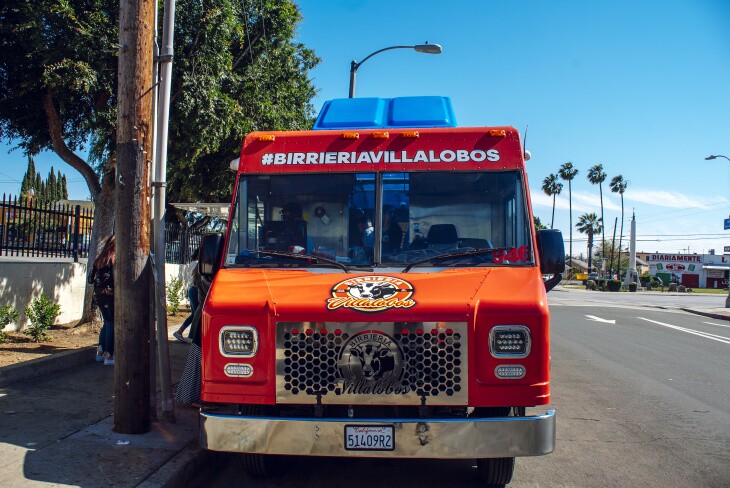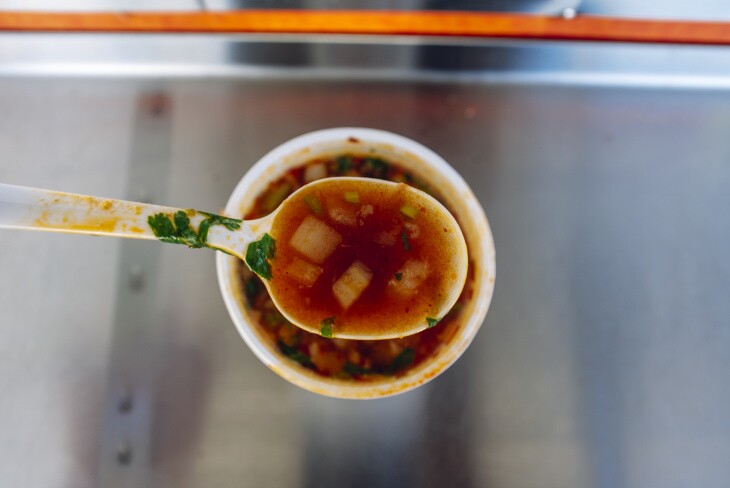Truth matters. Community matters. Your support makes both possible. LAist is one of the few places where news remains independent and free from political and corporate influence. Stand up for truth and for LAist. Make your tax-deductible donation now.
How Tijuana Tacos Became LA's Hottest Food Trend

It's 40 degrees on a Saturday morning in Inglewood in March, the kind of cold that gnaws at your toes and makes your knuckles crack and bleed. It is freezing, almost literally, but that hasn't stopped a crowd from gathering at four-month-old Birrieria Gomez, a Tijuana-style birria stand in a paved driveway on Lennox Boulevard.
Four employees race through their tasks as the shivering crowd shifts from foot to foot. Finally, our food arrives. Balancing Styrofoam plates stained bright red, we sip from cups of consomé rich with beef fat and buzzing with chiles as we dig into tacos, mulitas and quesatacos packed with slow-cooked beef. The crowds have been so large and so consistent that Birrieria Gomez flipped its stand into a full truck before the business hit five months.
About 15 miles northeast, near the Cinco Puntos intersection in East L.A., a line stretches around the corner at Birrieria Villalobos, another Tijuana-style birria specialist that recently outgrew the car wash where it opened on weekends and upgraded to a truck that's parked six days a week in this prime spot.

Birrieria Gonzalez Lounge, a six-month-old restaurant in East L.A., also draws a crowd. It's part of the rapidly expanding Birrieria Gonzalez empire, which now includes five trucks and two restaurants spread across East and South Los Angeles. Most have opened in the last year, and the owners already have plans to launch more trucks.
At night, the party moves to Tijuana-style grilled-meat stands like Angel's in North Hollywood, El Viejon in East L.A. and the much-loved Tire Shop in South L.A.
Tijuana-style tacos, both daytime birria operations and their nighttime counterparts, are having a moment, finding fans from South L.A. to the San Fernando Valley and from Venice to East L.A. It hasn't taken long for Instagram, the Los Angeles Times and even the Super Bowl to notice.

Birria goes boom
The exact parameters of Tijuana-style birria, a regional version of the classic Jalisciense party dish of slow-cooked meat served in its juices, are imprecise but the broad strokes are simple.
The birria is made with beef and the broth is heavily spiced and bright red from an array of chiles. It's served mostly for breakfast in antojito form — as tacos, mulitas, quesadillas, vampiros, et al. — and splashed with consomé, which you can also get on the side.
Teddy's Red Tacos is the most high-profile birria de res success story, with a truck in South L.A., a restaurant in Venice, a recent review in the L.A. Times and a featured moment in a major ESPN Deportes Super Bowl commercial. The name comes from a particular flourish. The tortillas are dipped in the consomé before being heated on the flat top, dying each one a deep crimson. The practice isn't unique but it's also far from ubiquitous.
Grilled Tijuana-style tacos have a rough set of guidelines. If you order con todo, your taco is dressed for you with onions, cilantro, salsa and a glob of guacamole that's made from avocado and nothing else, an intentionally under-seasoned counterpoint to the intensity of the meat and the salsa. The other distinguishing feature is the paper rectangle swaddled around each taco in a cone so that one corner sticks up like a cat's ear.
The essential part of Tijuana-style tacos, though, is the heat source. They should be cooked over mesquite wood, burning as close to the meat as possible so the protein chars quickly and is imbued with a smoky flavor.
At Tacos El Viejon, a year-old stand at Cesar Chavez and Hicks, near the aforementioned Cinco Puntos in East L.A., the star of the show is head taquero Ray Velazquez. Approaching customers salute him as he pokes huge lumps of mesquite charcoal under the grate, flipping and prodding and watching thin slabs of beef and fat links of chorizo. He works the grill with the all the attention and ten times the skill of a suburban dad at a summertime cookout. Sparks fly, embers spill onto the sidewalk. No one seems to mind being downwind of the smoke.

Honing their craft
Ray's son Alex Velazquez, who works at the stand and manages the Instagram account in the hours between finishing his engineering degree at Cal Poly Pomona, translates for his father as Ray describes the family's four-decade history in the taco business.
The Velazquez family originates in Puebla but in the early 1970s a group of them traveled to Tijuana to work as taqueros. They spent years learning Tijuana technique before fanning out across North America. Some of them opened taquerias back in Puebla, some in Veracruz and now, some have appeared in Los Angeles. In fact, a cousin operates Tacos Don Cuco, a Tijuana-style taqueria a few miles east.
It has taken the Velazquezes decades to perfect their craft and their recipes are closely guarded secrets, even among family members. The only way to learn, Alex says, is by working at the stand for a long time. Espionage may also be an option, he hints. Within the family, it may have already occurred.
Aside from the mesquite charcoal and pure guacamole, Alex says in his mind the only real rule for Tijuana-style tacos is the care taken with each step. "It's hard to say exactly," he says, "but everything has to be on point."
Which is to say that Tijuana-style tacos are like pornography — easy to recognize but tough to define and extremely popular on the internet.

The taco as status symbol
Almost every outfit has thousands of Instagram followers, from Tacos Don Cuco on the low end at 8,000 to Angel's Tijuana Tacos at 41K and Teddy's Red Tacos with more than 78,000 followers. What makes them so successful on Instagram?
The tacos photograph well, for one thing. The paper cones and bright green guacamole grab the scrolling eye without gimmickry. Many of the most popular Tijuana-style taco stands use identical post formatting, an abundance of esoteric hashtags and entreaties to "Tag Someone Who Loves Tacos" in the comments. This last bit is a quick way to spread awareness. It's like the flu, people sneezing friends' handles into posts, building a web of in-the-know taco fiends.
They have also become a status symbol, the latest beneficiary of the feedback loop between social media and traditional media. Foodies help make certain tacos popular on Instagram. Those tauqerias turn up in newspapers and on TV. Casual taco fans flock to these taquerias and post pictures of them online so they receive more acclaim and attention from media outlets.
When asked for his thoughts on the explosion of Tijuana-style tacos, Alex Velazquez cites the ease and the reach of Instagram, which he enjoys running for the family, and the recent loosening of street vending laws.
The Velazquezes had long wanted to set up a stand in East L.A. They had sized up the competition and found it lacking but when they debuted in January of 2018, they did it quietly to avoid legal hassles. Since the city enacted its new street food policy, in November 2018, they have finally felt comfortable operating on a regular schedule.
Now they're putting their four-decade legacy to work in Los Angeles. We are the lucky taco chasers who get to reap the smoky, guac-topped rewards.









